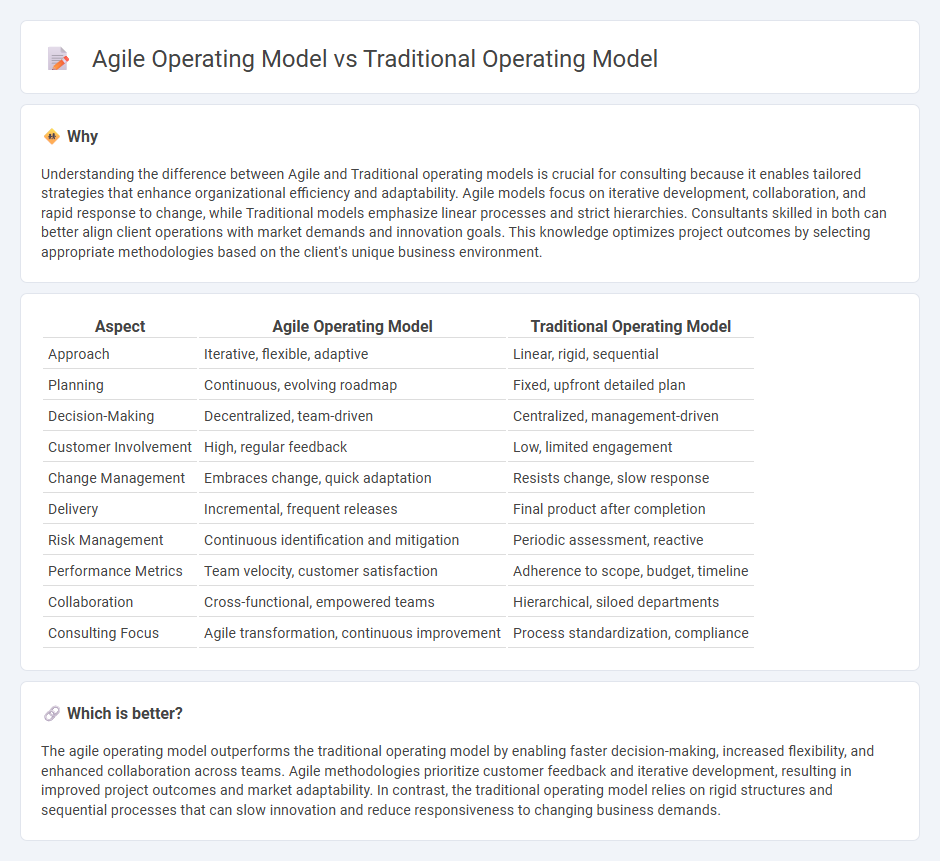
The Agile operating model emphasizes iterative development, cross-functional teams, and rapid adaptability, contrasting sharply with the Traditional operating model's linear processes and hierarchical structure. Agile drives faster decision-making and continuous improvement, optimizing project delivery in dynamic environments. Explore how adopting Agile can transform your organization's efficiency and responsiveness.
Why it is important
Understanding the difference between Agile and Traditional operating models is crucial for consulting because it enables tailored strategies that enhance organizational efficiency and adaptability. Agile models focus on iterative development, collaboration, and rapid response to change, while Traditional models emphasize linear processes and strict hierarchies. Consultants skilled in both can better align client operations with market demands and innovation goals. This knowledge optimizes project outcomes by selecting appropriate methodologies based on the client's unique business environment.
Comparison Table
| Aspect | Agile Operating Model | Traditional Operating Model |
|---|---|---|
| Approach | Iterative, flexible, adaptive | Linear, rigid, sequential |
| Planning | Continuous, evolving roadmap | Fixed, upfront detailed plan |
| Decision-Making | Decentralized, team-driven | Centralized, management-driven |
| Customer Involvement | High, regular feedback | Low, limited engagement |
| Change Management | Embraces change, quick adaptation | Resists change, slow response |
| Delivery | Incremental, frequent releases | Final product after completion |
| Risk Management | Continuous identification and mitigation | Periodic assessment, reactive |
| Performance Metrics | Team velocity, customer satisfaction | Adherence to scope, budget, timeline |
| Collaboration | Cross-functional, empowered teams | Hierarchical, siloed departments |
| Consulting Focus | Agile transformation, continuous improvement | Process standardization, compliance |
Which is better?
The agile operating model outperforms the traditional operating model by enabling faster decision-making, increased flexibility, and enhanced collaboration across teams. Agile methodologies prioritize customer feedback and iterative development, resulting in improved project outcomes and market adaptability. In contrast, the traditional operating model relies on rigid structures and sequential processes that can slow innovation and reduce responsiveness to changing business demands.
Connection
The agile operating model and traditional operating model are connected through their shared goal of optimizing organizational performance, with agile emphasizing flexibility and iterative processes, while traditional models focus on structured, hierarchical workflows. Consulting firms analyze both models to design hybrid frameworks that balance speed and control, enhancing adaptability without sacrificing stability. This connection enables businesses to implement scalable solutions that respond effectively to market changes and operational challenges.
Key Terms
Hierarchical Structure vs. Cross-functional Teams
Traditional operating models emphasize a hierarchical structure where decision-making flows top-down, creating clear roles and responsibilities but often slowing adaptability. Agile operating models prioritize cross-functional teams that foster collaboration, rapid decision-making, and responsiveness to change by integrating diverse expertise in dynamic workflows. Explore how shifting from hierarchy to agility can transform your organization's efficiency and innovation.
Sequential Processes vs. Iterative Cycles
The traditional operating model emphasizes sequential processes with defined stages like planning, execution, and delivery, ensuring predictability and structured workflows. In contrast, the agile operating model relies on iterative cycles, promoting continuous feedback, adaptability, and faster response to change through sprints or iterations. Explore detailed comparisons to understand how these models impact project success and organizational agility.
Predictive Planning vs. Adaptive Planning
The traditional operating model relies heavily on predictive planning, utilizing fixed schedules and detailed forecasts to guide project execution and resource allocation. In contrast, the agile operating model emphasizes adaptive planning, allowing teams to respond flexibly to changing requirements and emerging challenges through iterative development cycles. Discover more about how these planning approaches impact organizational efficiency and innovation.
Source and External Links
What Is A Traditional Business Model? - A Comprehensive Guide - A traditional operating model is a structured, hierarchical approach that relies on established methods, clear roles, and conventional channels to deliver products or services, emphasizing stability and predictability.
What are Business Operating Models? | Quantive - Traditional operating models feature a top-down chain of command, data silos, multiple unaligned initiatives, and periodic (quarterly/annual) performance reviews, contrasting with modern models that focus on data transparency and continuous alignment.
Time to Transform the "Traditional" HR Operating Model? - In traditional HR, the operating model often follows a three-pillar structure (Centers of Excellence, Shared Services, Business Partners), providing clear role definitions and process focus, which supports organizational growth and professionalization.
 dowidth.com
dowidth.com